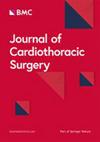Stroke after heart valve surgery: a single center institution report
IF 1.5
4区 医学
Q3 CARDIAC & CARDIOVASCULAR SYSTEMS
引用次数: 0
Abstract
Stroke is a potentially debilitating complication of heart valve replacement surgery, with rates ranging from 1 to 10%. Despite advancements in surgical techniques, the incidence of postoperative stroke remains a significant concern, impacting patient outcomes and healthcare resources. This study aims to investigate the incidence, risk factors, and outcomes of in-hospital adverse neurologic events, particularly stroke, following valve replacement. The analysis focuses on identifying patient characteristics and procedural factors associated with increased stroke risk. This retrospective study involves a review of 417 consecutive patients who underwent SVR between January 2004 and December 2022. The study cohort was extracted from a prospectively recorded cardiac intensive care unit database. Preoperative and perioperative data were collected, and subjects with specific exclusion criteria were omitted from the analysis. The analysis includes demographic information, preoperative risk factors, and perioperative variables. The study identified a 4.3% incidence of postoperative stroke among SVR patients. Risk factors associated with increased stroke susceptibility included prolonged cardiopulmonary bypass time, aortic cross-clamp duration exceeding 90 min, prior stroke history, diabetes mellitus, and mitral valve annulus calcification. Patients undergoing combined procedures, such as aortic valve replacement with mitral valve replacement or coronary artery bypass grafting with AVR and MVR, (OR = 10.74, CI:2.65–43.44, p-value = < 0.001) and (OR = 11.66, CI:1.02–132.70, p-value = 0.048) respectively, exhibited elevated risks. Internal carotid artery stenosis (< 75%) and requiring prolonged inotropic support were also associated with increased stroke risk(OR = 3.04, CI:1.13–8.12, P-value = 0.026). The occurrence of stroke correlated with extended intensive care unit stay (OR = 1.12, CI: 1.04–1.20, P-value = 0.002) and heightened in-hospital mortality. In conclusion, our study identifies key risk factors and underscores the importance of proactive measures to reduce postoperative stroke incidence in surgical valve replacement patients.心脏瓣膜手术后中风:单中心机构报告
中风是心脏瓣膜置换手术的潜在并发症,发病率为 1%-10%。尽管手术技术不断进步,但术后中风的发生率仍是一个重大问题,影响着患者的预后和医疗资源。本研究旨在调查瓣膜置换术后院内不良神经事件(尤其是中风)的发生率、风险因素和预后。分析的重点是确定与中风风险增加相关的患者特征和手术因素。这项回顾性研究回顾了 2004 年 1 月至 2022 年 12 月间接受 SVR 的 417 例连续患者。研究队列来自于一个有前瞻性记录的心脏重症监护室数据库。研究人员收集了术前和围手术期数据,并在分析中忽略了具有特定排除标准的受试者。分析包括人口统计学信息、术前风险因素和围手术期变量。研究发现,SVR 患者术后中风的发生率为 4.3%。与中风易感性增加相关的风险因素包括心肺旁路时间延长、主动脉交叉钳夹持续时间超过 90 分钟、既往中风病史、糖尿病和二尖瓣环钙化。接受联合手术的患者,如主动脉瓣置换术合并二尖瓣置换术或冠状动脉旁路移植术合并主动脉瓣置换术和二尖瓣置换术,分别显示出更高的风险(OR = 10.74,CI:2.65-43.44,p 值 = < 0.001)和(OR = 11.66,CI:1.02-132.70,p 值 = 0.048)。颈内动脉狭窄(< 75%)和需要长时间肌力支持也与中风风险增加有关(OR = 3.04,CI:1.13-8.12,P 值 = 0.026)。中风的发生与重症监护室住院时间延长(OR = 1.12,CI:1.04-1.20,P 值 = 0.002)和院内死亡率升高相关。总之,我们的研究确定了关键的风险因素,并强调了采取积极措施降低手术瓣膜置换患者术后中风发生率的重要性。
本文章由计算机程序翻译,如有差异,请以英文原文为准。
求助全文
约1分钟内获得全文
求助全文
来源期刊

Journal of Cardiothoracic Surgery
医学-心血管系统
CiteScore
2.50
自引率
6.20%
发文量
286
审稿时长
4-8 weeks
期刊介绍:
Journal of Cardiothoracic Surgery is an open access journal that encompasses all aspects of research in the field of Cardiology, and Cardiothoracic and Vascular Surgery. The journal publishes original scientific research documenting clinical and experimental advances in cardiac, vascular and thoracic surgery, and related fields.
Topics of interest include surgical techniques, survival rates, surgical complications and their outcomes; along with basic sciences, pediatric conditions, transplantations and clinical trials.
Journal of Cardiothoracic Surgery is of interest to cardiothoracic and vascular surgeons, cardiothoracic anaesthesiologists, cardiologists, chest physicians, and allied health professionals.
文献相关原料
| 公司名称 | 产品信息 | 采购帮参考价格 |
|---|
 求助内容:
求助内容: 应助结果提醒方式:
应助结果提醒方式:


